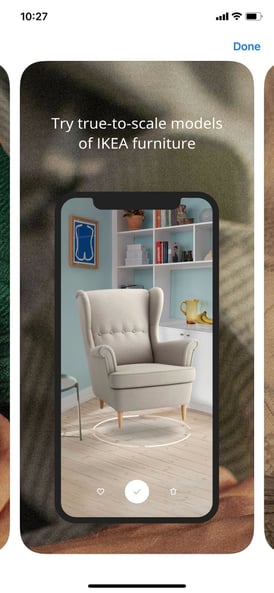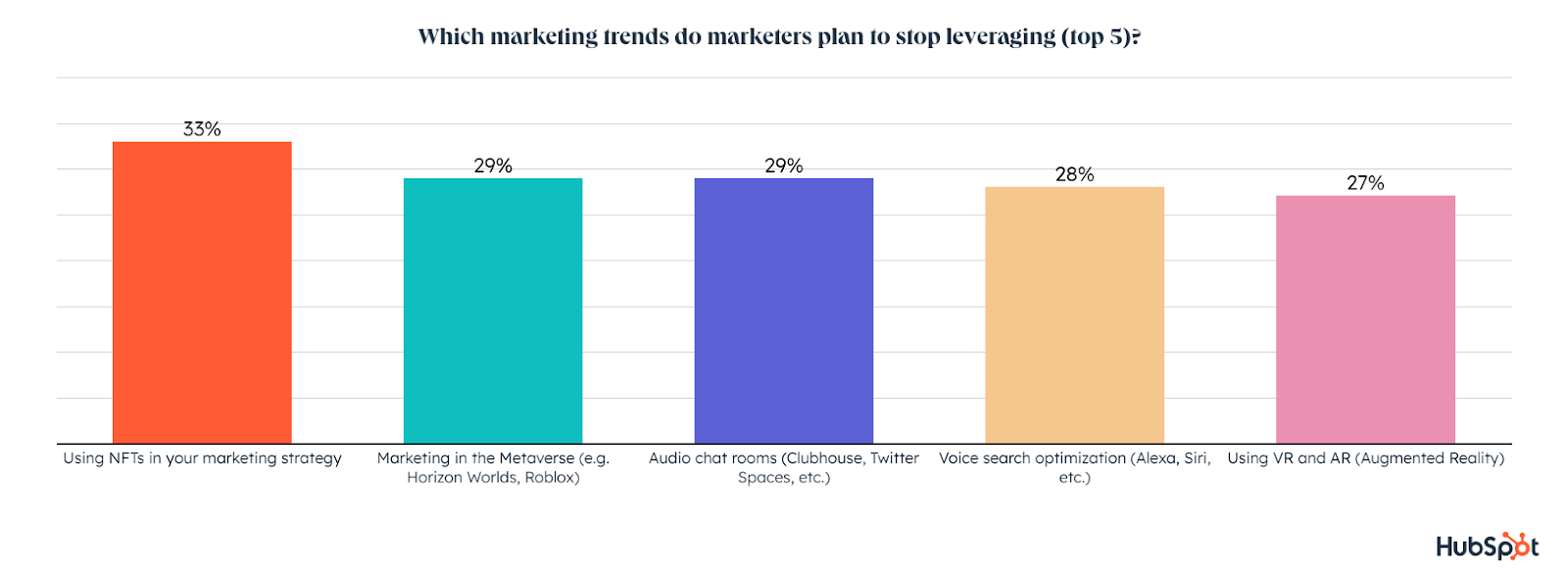Understanding the concepts can get confusing as the terms are used interchangeably, but each has its unique set of characteristics and applications.
Download Now: 2022 State of U.S. Consumer Trends Report
In this post, we’ll break down the difference between augmented and virtual reality, their unique marketing applications, and how consumers feel about them.
Table of Contents
- What is augmented reality (AR)?
- What is virtual reality (VR)?
- What is the difference between AR and VR?
- Use Cases for AR and VR
- AR vs. VR: Which Is More Effective for Marketing
What is augmented reality (AR)?
Augmented reality (AR) layers virtual elements on top of a real-world scene, allowing users to exist in the space they’re physically in but benefit from the augmented elements in their experience.
Pokémon GO is one of the most popular and notable examples of AR, where Pokémon characters are superimposed into a real-life setting, like someone’s backyard or outside of their favorite restaurant.
What is virtual reality (VR)?
Virtual reality (VR) is any software that immerses users in a three-dimensional interactive virtual environment, usually using a VR sensory device that brings real-world actions into a virtual world. Many VR experiences are 360 degrees.
It’s a computer-generated simulation, and each virtual reality world allows people to fully participate in the unique world.
What is the difference between AR and VR?
The most notable and significant difference between AR and VR is that AR adds things to someone’s existing world, and VR immerses someone in a new world. A VR world is a new reality, and an AR supplements an existing reality.
In addition, many VR experiences require headsets or sensory devices to work, while AR does not. It’s also commonly said that AR is 75% reality and 25% virtual, and VR is 25% reality and 75% virtual.
They’re similar in offering immersion for users, VR in an entirely new world, and 3D and virtual content.
Use Cases for AR and VR
Marketing applications for AR and VR can vary, so let’s discuss a few examples.
For one, AR is a high-quality tool for product marketing. The tech can overlay virtual elements to actual reality, allowing consumers to “test” products in real-life scenarios to see how they like it.
The IKEA Place app is a great example of AR product marketing. App users can select a piece of furniture they like and superimpose a to-scale model in their real-life space to see how it looks before purchasing. This opportunity can increase buyer confidence and sales if people see that they like how a product fits into their lifestyle.

VR marketing applications immerse consumers in branded experiences that can build awareness, recognition, and satisfaction. People can explore the world you create, learn more about your products, and even purchase VR products.
Gucci Town is a great example of an immersive VR brand experience. It’s the luxury fashion house’s virtual world within the Roblox metaverse, where people can explore, learn about its history, and connect with people in the game. They can also purchase exclusive Gucci Town clothing for their Roblox avatars.
These worlds are a new, unique, and exciting way of interacting with their favorite brands that don’t come from watching a TikTok, visiting a store, or reading an email newsletter.
An application of AR and VR is experiential marketing, where you invite your audiences to interact with your brand as a form of marketing. It’s a valuable application because humans want to build that kind of relationship with a brand, and a fun and immersive real-world experience can build an emotional connection.
Netflix’s Stranger Things Experience was an AR experiential marketing experience to promote the show’s upcoming season. Fans visited an in-person location and became part of an interactive AR game experience to make them feel like they’re in the Stranger Things world.
Consumer Preferences for AR vs. VR
Given their marketing applications, it makes sense to be curious about consumers’ thoughts.
We conducted a survey to ask consumers about their use of AR and VR and if they had preferences for either. Respondents reported using AR and VR on similar levels, most often saying they use it a few days a week or once a month or less.
When we asked consumers if they’ve bought AR apps, tools, devices, or software, a majority said no (55%), 25% said yes, and 20% were thinking about it. The numbers were relatively similar for VR: 50% said no, 30% said yes, and 20% said they were considering it.
.png?width=1012&height=506&name=AR%20vs%20VR%20glimpse%20(1).png)
When asked if they preferred AR or VR, the majority said VR. Their reasons for preferring it were:
- It’s a more immersive experience that takes them to an entertaining world,
- The graphics and movements are smoother, and the visuals are better,
- It has more applications than AR and is better for video games and interactive entertainment,
- They’re more familiar with VR than AR.
Those who preferred AR said they appreciated it because it was more reality integrated and felt more real, they liked how they could add virtual things to real-world views and that AR was better for quality of life (QoL) applications like education, shopping, navigation, and healthcare.
A fair amount of respondents also said they didn’t prefer either or have an interest in using either. Some explicitly stated that they didn’t understand what either was, and some showed that they might not understand the difference by saying that VR is more realistic than AR when AR is the more life-like option.
This tracks with the results of our latest Consumer Trends Survey, which found that only 39% of respondents understood the concept of the metaverse (which can blend AR and VR elements). In addition,
- Only 8% of U.S. adults have ever visited a metaverse (this remained consistent between 2022 and 2023 surveys.)
- 47% bought virtual items other than NFTs, down 25% from May 2022, meaning that marketers planning to sell products in the virtual world might find consumers less willing or interested in buying.
Engagement with virtual worlds has waning hype, and consumers invest less in virtual items.
Business Preferences for AR and VR [Data]
Our marketing strategy report from 2021 found that 35% of marketers were leveraging AR or VR in their strategies, but in 2023, more than a quarter of marketers plan to stop using VR and AR. It’s still intriguing for marketers, but it can be challenging to execute on because equipment can be expensive.
However, 14% of marketers do plan on leveraging and exploring VR/AR for the first time in 2023.

AR vs. VR: Which Is More Effective for Marketing [Data]
There is no right or wrong answer as to whether AR or VR is more effective for marketing — it depends entirely on your business goals.
For example, a study conducted by Tim Hilken in the Netherlands found that both AR and VR increased customers’ purchase intentions. AR was more effective at stimulating purchases, but VR was more effective at creating positive brand attitudes. Both were effective at fulfilling a marketing goal, but each for a specific goal.
True sensory immersive VR experiences can be costly and require consumers to have the right devices to use them, but our survey results found that most consumers haven’t invested in them. However, virtual worlds like Horizon Worlds and Roblox don’t require sensory devices.
AR can be a cheaper option, but it doesn’t have the fully immersive brand experience that allows consumers to disappear into an alternate reality. But, the Stranger Things Experience did effectively create an immersive AR experience.
This is not to say that marketers shouldn’t use either of them. It boils down to this: AR and VR are both emerging technologies for marketing. Instead of changing your entire strategy to revolve around AR and VR, consider leveraging them as experimental tools. For example, you can create an AR experience as product marketing for a new offer or offer a fun VR game for people to play on your website.
You can test it out and give your audiences a new way to interact with your business without relying on it to meet your marketing goals. It can also be costly, so you’re preserving marketing budgets and not spending all of your money on channels that might not be as effective as you’d hoped.
To find inspiration, note what other brands are doing and what people are saying online about their experiences.
Over To You
AR and VR have been around for a long time but are still emerging tools for marketers. Consider your business needs, and note what other brands are doing and what people say online about their experiences.
Staying ahead of the trends simply means paying attention. If VR and AR marketing experiences skyrocket in popularity and become a must-have strategy, you’ll already know how your business needs to respond.